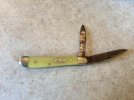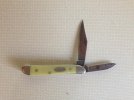-
The BladeForums.com 2024 Traditional Knife is available! Price is $250 ea (shipped within CONUS).
Order here: https://www.bladeforums.com/help/2024-traditional/
You are using an out of date browser. It may not display this or other websites correctly.
You should upgrade or use an alternative browser.
You should upgrade or use an alternative browser.
Cleaning/Lubing a folder
- Thread starter Bobbyz24
- Start date
- Joined
- Jan 27, 2013
- Messages
- 2,078
Looks like it's in pretty rough shape, I would want to get inside the knife to clean something like that. Seems to me that the pivot will be pretty tough to get to, but someone else might have a good suggestion. Personally, I would spend the $30 to give my dad a nice little gift.


- Joined
- Apr 12, 2009
- Messages
- 13,508
This is basically what I do with my knives, when they need it:
( BTW, that knife may not be as old as the rust/pitting may seem to imply. If I'm seeing it correctly through the dark patina, I think I can see an alternating pattern of X's and dots across the top of the tang stamp, which would indicate post-2010 vintage. Looks like 'X X.X', which may be part of the 2011 stamp. )
David
- Wash the knife in hot water & dish detergent, such as Dawn, Palmolive, etc. Work the joints thoroughly while doing so (be careful; the knife will be slippery).
- Rinse it out thoroughly in hot water, again exercising the joints while doing so.
- Dry it all off; use a paper towel or clean rag to dry all you can reach. The hot water wash & rinse should warm up the knife nicely, which will speed evaporation of moisture from the nooks & crannies. Can also rinse the knife with isopropyl alcohol, which also will flush out moisture.
- A little WD-40 in the joints, and between liners & springs, can further eliminate any moisture. If the blades are Case's CV (non-stainless), the WD-40 will add a little bit of rust-protection while making sure everything's good & dry.
- Can also lube with oil/lube of your preference, if desired.
( BTW, that knife may not be as old as the rust/pitting may seem to imply. If I'm seeing it correctly through the dark patina, I think I can see an alternating pattern of X's and dots across the top of the tang stamp, which would indicate post-2010 vintage. Looks like 'X X.X', which may be part of the 2011 stamp. )
David
Last edited:
- Joined
- Sep 15, 2009
- Messages
- 839
I use a similar technique as the poster above but I'll add that these "rust erasers" work really well for fixing up old rusty knife blades. They won't bring back a mirror polish but they do leave a nice satin finish. http://www.knifecenter.com/item/UC135A/
- Joined
- Apr 12, 2009
- Messages
- 13,508
Looks good! :thumbup:
The 'patina' left behind won't harm the steel at all, and it adds some hard-working character to the knife.
How's the opening/closing? Any smoother than before, or have you worked on cleaning the pivot yet?
David
The 'patina' left behind won't harm the steel at all, and it adds some hard-working character to the knife.
How's the opening/closing? Any smoother than before, or have you worked on cleaning the pivot yet?
David
- Joined
- Apr 12, 2009
- Messages
- 13,508
I completely submerged the thing in liquid wrench. Worked it back and for both blades about 15 minutes a piece. It's.. A little stiff but definitely better than it was
The Case 'Peanut' (that's what this one is) has been known for somewhat stiff opening & closing, so it may be inherent to some extent. The half-stops can sometimes make opening/closing tricky in combination with small & shallow nail nicks, depending on if one is used to them or not.
Now I am satisfied with the job I've done here. But let's say I wanted to get that thing back to like new. Shine wise I mean. What would I need to do in that case?
If wanting to remove all pitting and restore a full shine, a sequence of sandpaper would be needed. Starting with something a little lower, like perhaps 400 grit, then progressing through higher grits to 2000+. A tighter sequence, with narrow jumps in grit, is always more effective. After sanding, polishing with Flitz/Simichrome paste can take it further. Even with this small knife, it'd take a lot of work and time. Alternatively, you could just use the polishing paste on the existing finish; it'd leave the deep pitting, but would otherwise give it a more polished look, and also help protect it from rusting a little more. Removing all of the pitting won't be easy, so you'll need to decide if it's worth going that far with it.
Personally, I'd have no issues at all with the appearance as it is now. Lots of fans of that patinated look here; looks like a knife with some hard-working history behind it.
David



